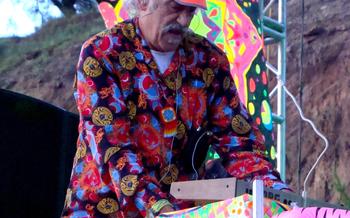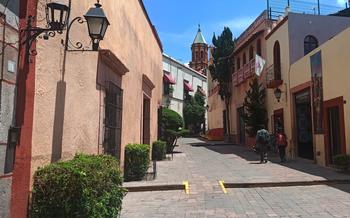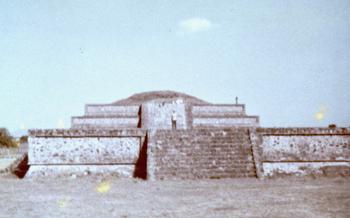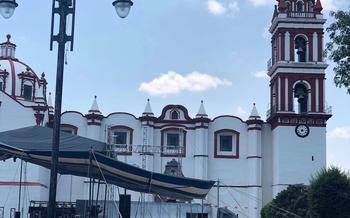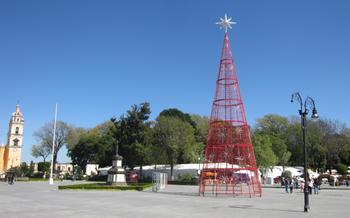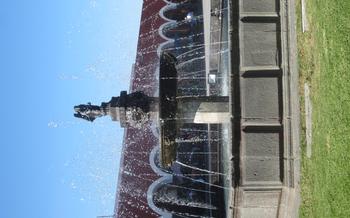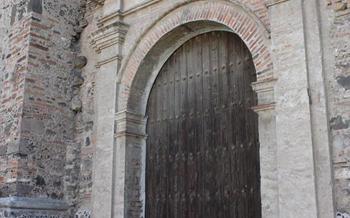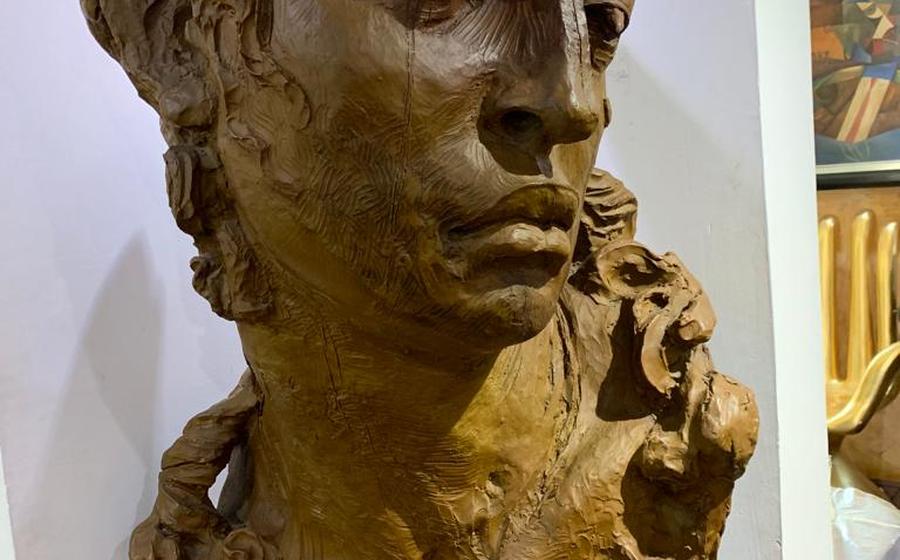
La Griega Archaeological Zone
- The Antiquity of La Griega Archaeological Zone
- Location and Accessibility
- Historical Overview
- Main Structures and Features
- The Great Pyramid of La Griega
- The Temple of the Feathered Serpent
- The Ball Court Complex
- The Residential Areas
- La Griega Museum: A Treasure Trove of Ancient Discoveries
- La Griega Archaeological Park: A Place for Recreation and Cultural Immersion
- Best Time to Visit
- Entrance Fees and Hours of Operation
- Local Cuisine
- Accommodation
- Insider Tips for an Unforgettable Visit:
The Antiquity of La Griega Archaeological Zone
La Griega Archaeological Zone is a fascinating glimpse into the ancient past of Mexico. The site dates back to the Classic period of Mesoamerican civilization, roughly between 200 and 600 AD. Archaeological evidence suggests that La Griega was once a thriving pre-Hispanic city, with a population of several thousand people. The city was likely abandoned around the 8th century AD, but its ruins were rediscovered in the 19th century and have since been extensively excavated.
Historical Significance
La Griega is significant for its role as a major cultural and economic center in the region during the Classic period. The site is home to a number of impressive structures, including pyramids, temples, ball courts, and residential areas. These structures provide valuable insights into the daily lives and beliefs of the ancient inhabitants of La Griega.
Archaeological Discoveries
Excavations at La Griega have uncovered a wealth of artifacts, including pottery, figurines, and tools. These artifacts shed light on the artistic and technological achievements of the city's inhabitants. In addition, archaeologists have found evidence of trade with other regions of Mesoamerica, suggesting that La Griega was an important part of a larger cultural network.
Cultural Legacy
La Griega Archaeological Zone is a valuable reminder of the rich cultural heritage of Mexico. The site provides a glimpse into the lives of the ancient Mesoamericans, and it helps us to understand the development of their civilization. La Griega is also a popular tourist destination, and it plays an important role in promoting cultural awareness and understanding.
Location and Accessibility
The La Griega Archaeological Zone is strategically located in the municipality of Cadereyta de Montes, in the state of Querétaro, Mexico. It is situated at the coordinates 20°42'00"N 100°03'00"W, and is easily accessible by various means of transportation, making it a convenient destination for travelers.
To reach La Griega, visitors can opt for a scenic drive through the picturesque landscapes of Querétaro. The archaeological zone is approximately 80 kilometers (50 miles) northeast of the city of Querétaro, and the journey takes around 1 hour and 30 minutes by car. Alternatively, regular bus services operate from the city to Cadereyta de Montes, with a stop near the archaeological site.
For those seeking a more immersive experience, guided tours are available from local tour operators. These tours typically include round-trip transportation from Querétaro, allowing visitors to sit back and enjoy the historical insights provided by experienced guides. Regardless of the chosen mode of transportation, the La Griega Archaeological Zone offers a remarkable opportunity to step back in time and explore the rich cultural heritage of Mexico.
Historical Overview
The history of La Griega Archaeological Zone is rich and complex, spanning multiple periods and civilizations. In the pre-Hispanic era, the area was inhabited by various indigenous groups, including the Otomí and the Chichimecas. They built the city of Xaltocan, which became a significant regional center. In the 16th century, the Spanish conquistadors arrived in the region and encountered fierce resistance from the indigenous peoples. After several battles, the Spanish eventually gained control of the area and established the city of Querétaro. During the colonial period, La Griega Archaeological Zone was largely abandoned and fell into disrepair. It was not until the late 19th century that archaeologists began to explore the site and uncover its hidden treasures.
Main Structures and Features
The La Griega Archaeological Zone is home to various impressive structures and features that demonstrate the architectural prowess and cultural significance of the pre-Hispanic civilizations that inhabited the region.
Among the most prominent structures are the pyramids, which served as religious and ceremonial centers. The Great Pyramid of La Griega stands as the most impressive, with its massive size and intricate construction.
Another significant feature is the Temple of the Feathered Serpent, a unique and well-preserved structure dedicated to the revered Mesoamerican deity Quetzalcoatl. The temple's intricate carvings and sculptures offer valuable insights into the religious beliefs and artistic expressions of the ancient inhabitants.
The archaeological zone also boasts a ball court complex, where the Mesoamerican ball game, known as "juego de pelota," was played. The ball court's dimensions and layout suggest that the game held both ritualistic and entertainment purposes.
Finally, the residential areas provide a glimpse into the daily lives of the ancient inhabitants. These areas consist of various housing structures, each with unique features and designs, reflecting the social organization and lifestyle of the community.
The Great Pyramid of La Griega
The Great Pyramid of La Griega is a colossal stone structure that dominates the archaeological zone. Its imposing presence reflects the architectural prowess and symbolic significance held by the ancient civilizations that constructed it. The pyramid, estimated to have been built around 500-600 AD, stands as a testament to their advanced knowledge of engineering and construction techniques.
The pyramid's grand scale is evident in its dimensions, rising approximately 30 meters (98 feet) in height and extending over a vast area. Its stepped sides, meticulously crafted from large stone blocks, create a sense of grandeur and majesty. The intricate design of the pyramid showcases the architectural mastery of the La Griega builders, who employed precise calculations and alignments to achieve its impressive form.
Beyond its physical attributes, the Great Pyramid holds deep symbolic significance. It is believed to have served as a sacred temple or ceremonial center, where religious rituals and ceremonies were performed. The pyramid's alignment with celestial events, such as solstices and equinoxes, further reinforces its astronomical and cosmological importance. The interior of the pyramid remains largely unexplored, holding the potential for future archaeological discoveries that may shed light on its specific functions and rituals.
The Temple of the Feathered Serpent
The Temple of the Feathered Serpent is one of the most remarkable structures within the La Griega Archaeological Zone. Dedicated to the revered deity Quetzalcoatl, the temple showcases exceptional architectural features and holds significant religious and artistic value.
Unique Characteristics
The temple's most striking feature is its distinctive design, which incorporates a stepped platform supporting a single chamber. Unlike other temples in the region, which typically feature multiple chambers, the Temple of the Feathered Serpent's singular chamber exudes an aura of mystery and sacredness.
Religious Significance
Quetzalcoatl, often depicted as a feathered serpent, was a prominent deity in Mesoamerican mythology, representing wisdom, creation, and rebirth. The temple served as a sacred space for religious ceremonies and rituals honoring this revered deity. Elaborate offerings and prayers were made to Quetzalcoatl, seeking his blessings and guidance.
Artistic Representations
The temple's interior walls are adorned with intricate bas-relief sculptures depicting scenes from Quetzalcoatl's mythology. These finely crafted carvings showcase the artistic prowess of the ancient artisans and provide valuable insights into the religious beliefs and practices of the time.
The Ball Court Complex
The ball game was an essential part of Mesoamerican culture, and La Griega is home to an impressive ball court complex that offers insights into this ancient sport.
La Griega ball court is one of the largest and best-preserved in the region. It is about 70 meters long and 14 meters wide with sloping sides and two raised platforms at the ends.
The central playing field is marked by a series of stone markers and rings, which were used to keep score and guide the trajectory of the ball. The game was played with a solid rubber ball, and the objective was to hit the ball through a stone hoop placed high on the walls of the court.
In addition to its sporting function, the ball court also had religious and symbolic significance. It was believed that the game represented the struggle between opposing forces, such as light and dark, or life and death. It was also associated with fertility and the agricultural cycle.
During the game, players wore protective gear, such as helmets and knee pads, and the outcome could have important implications for the community. A victory could bring good fortune, while defeat could lead to drought or other misfortunes.
The Residential Areas
Residential areas in La Griega are dispersed throughout the site, providing insights into the daily lives of its inhabitants. These structures, typically composed of small, rectangular rooms arranged around a central courtyard, served as living quarters for families. Archaeological investigations have revealed evidence of hearths, grinding stones, and other domestic artifacts, indicating that these spaces were used for cooking, food preparation, and various household activities.
The social organization of La Griega was likely hierarchical, with a ruling elite residing in larger and more elaborate structures. These elite residences often featured multiple rooms, courtyards, and elevated platforms, suggesting a higher status within the community. The close proximity of residential areas to the ceremonial center further reinforces the idea of a stratified society, with the ruling class residing near the religious and political heart of the city.
Studying the housing structures and daily life of the inhabitants of La Griega provides valuable insights into the social and cultural dynamics of this ancient city. These residential areas offer a glimpse into the domestic sphere of the past, shedding light on the cotidiano reality of the people who built and inhabited this remarkable archaeological site.
La Griega Museum: A Treasure Trove of Ancient Discoveries
La Griega Museum stands as a custodian of the archaeological wonders unearthed from La Griega's ancient metropolis. Within its walls, a captivating journey through time unfolds, showcasing a plethora of artifacts that unravel the rich tapestry of this ancient civilization.
Visitors embark on an immersive expedition, encountering intricately carved sculptures, pottery adorned with vibrant hues, and remnants of daily life that tell tales of a bygone era. Each exhibit is meticulously curated, providing insights into the cultural practices, religious beliefs, and artistic expressions of La Griega's inhabitants.
Interactive displays engage visitors, allowing them to virtually reconstruct ancient structures, decipher hieroglyphics, and experience the thrill of archaeological discoveries firsthand. Through these interactive experiences, La Griega Museum brings the past to life, fostering a deeper appreciation for the ingenuity and artistry of this ancient Mesoamerican society.
La Griega Archaeological Park: A Place for Recreation and Cultural Immersion
Beyond its historical and archaeological significance, La Griega offers a tranquil setting for visitors to relax and immerse themselves in the ancient culture. The archaeological park encompasses a network of well-maintained walking trails that meander through the ruins, allowing visitors to explore the site at their own pace. Along the trails, shaded picnic areas provide respite from the sun and invite visitors to enjoy a leisurely meal surrounded by history.
The park also serves as a venue for cultural events and festivals throughout the year. These events celebrate the rich heritage of the region and offer visitors a chance to experience traditional music, dance, art, and cuisine. Whether it's a traditional dance performance or a vibrant art exhibition, these events bring the ancient ruins to life and create a lively atmosphere within the park.
Best Time to Visit
Timing is Everything
The best time to visit La Griega Archaeological Zone is during the shoulder seasons, from October to November and from March to April. During these months, the weather is pleasant, with warm days and cool nights. The rains have subsided, and the humidity is lower, making it more enjoyable to explore the ruins.
Fewer Crowds, More Enjoyment
Another advantage of visiting during the shoulder seasons is that there are fewer tourists, allowing you to experience the site without the hustle and bustle of the peak season. This means you'll have more time and space to admire the ruins, take photos, and soak in the history and culture of La Griega.
Special Events
If you're interested in special events, plan your visit to coincide with the annual Festival of the Dead in early November. During this festival, the archaeological zone comes alive with colorful altars, traditional dances, and music, honoring the deceased and celebrating their lives. It's a unique and immersive experience that allows you to witness Mexican culture and traditions firsthand.
Entrance Fees and Hours of Operation
The La Griega Archaeological Zone welcomes visitors with affordable entrance fees, ensuring that everyone can explore its wonders without breaking the bank. The standard ticket price for adults is [price], while children and students can enjoy reduced rates. It's worth noting that guided tours are available and highly recommended for those seeking deeper insights into the site's history and significance. These tours are led by knowledgeable experts and provide an enriching experience for visitors.
The archaeological zone is open to the public from [time] to [time] on all days of the week. This provides ample flexibility for tourists to plan their visit according to their schedule. It's advisable to arrive early in the morning to beat the crowds and enjoy the serene atmosphere of the site. Alternatively, late afternoon visits offer a beautiful golden light that enhances the photography opportunities.
Local Cuisine
The vibrant flavors of Queretaro's cuisine are a testament to the region's rich cultural heritage. Visitors to La Griega Archaeological Zone should not miss the opportunity to savor the local culinary delights.
Must-Try Dishes:
- Enchiladas Queretanas: Corn tortillas smothered in a rich, spicy sauce, filled with cheese and topped with fresh cream and crumbled cheese.
- Gorditas de Maíz: Thick corn cakes stuffed with various fillings, such as shredded beef, carnitas, or cheese.
- Pambazos: Fried bread rolls filled with potatoes and chorizo, dipped in a spicy tomato sauce.
- Sopa Queretana: A hearty soup made with lamb or beef broth, vegetables, and chunks of bread.
Local Restaurants:
- El Mesón de los Poetas: A charming restaurant housed in a colonial-era building, serving traditional Queretaran cuisine with a modern twist.
- La Cocinería de las Monjas: A rustic eatery run by nuns, offering authentic recipes passed down through generations.
- El Patio Queretano: A lively restaurant with a beautiful courtyard, serving regional specialties and live music.
Street Food Delights:
- Gorditas de Migas: Corn cakes filled with refried beans and fried pork rinds.
- Tacos de Barbacoa: Tender barbacoa (slow-cooked lamb or beef) served on corn tortillas with salsa and guacamole.
- Esquites: A cup of boiled corn kernels topped with mayonnaise, chili powder, and lime juice.
Accommodation
When planning your visit to La Griega Archaeological Zone, you'll want to consider accommodation options that offer convenience, comfort, and proximity to the site. Several hotels and guesthouses are located near the archaeological zone, providing a range of options to suit different budgets and preferences.
One popular choice is the Hotel La Griega, situated just a short walk from the entrance to the archaeological zone. This charming hotel offers comfortable rooms with traditional Mexican décor, as well as a swimming pool, restaurant, and bar.
For those seeking a more luxurious experience, the Hacienda La Griega is an excellent option. Set in a beautifully restored 18th-century hacienda, this hotel offers elegant rooms and suites, a spa, a gourmet restaurant, and stunning views of the surrounding countryside.
If you're on a tighter budget, several guesthouses and hostels are available within walking distance of the archaeological zone. These offer basic but clean and comfortable accommodations at an affordable price.
When booking your accommodation, it's advisable to do so in advance, especially if you're visiting during peak tourist season. It's also worth checking for any special offers or discounts that may be available.
Insider Tips for an Unforgettable Visit:
Hidden Gems: - Venture off the beaten path to discover the less-visited sections of the site, such as the smaller pyramids and temples nestled among the dense vegetation.
Adventure Seekers: - For a thrilling experience, embark on a hot air balloon ride over the archaeological zone at sunrise or sunset to admire the breathtaking views from above.
Photography Enthusiasts: - Capture the essence of the site by arriving early in the morning or late in the afternoon when the golden light casts a magical glow on the ancient structures.
Unforgettable Souvenirs: - Visit the local artisan market to purchase handmade crafts and souvenirs inspired by the rich cultural heritage of the region.
